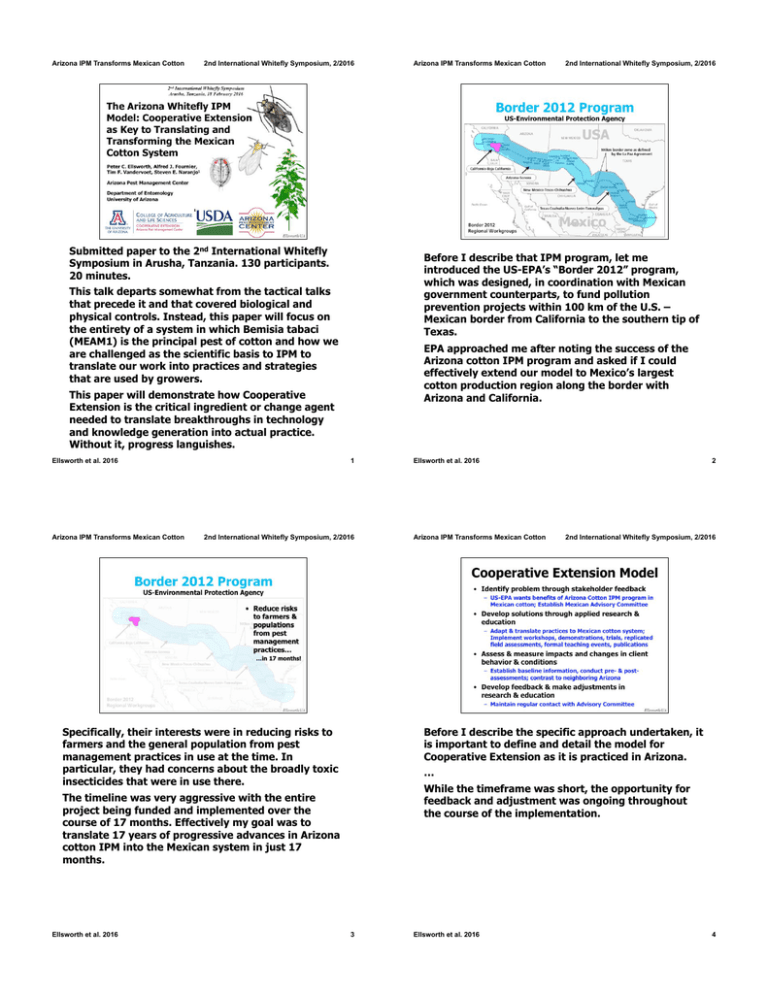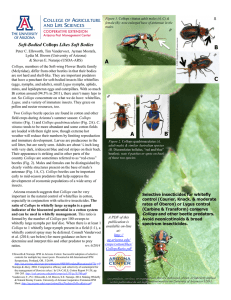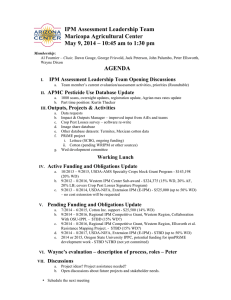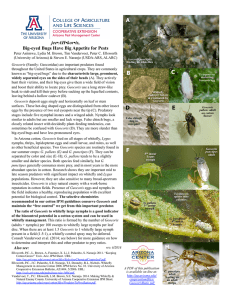Arizona IPM Transforms Mexican Cotton 2nd International Whitefly Symposium, 2/2016
advertisement

Arizona IPM Transforms Mexican Cotton 2nd International Whitefly Symposium, 2/2016 Submitted paper to the 2nd International Whitefly Symposium in Arusha, Tanzania. 130 participants. 20 minutes. EPA approached me after noting the success of the Arizona cotton IPM program and asked if I could effectively extend our model to Mexico’s largest cotton production region along the border with Arizona and California. This paper will demonstrate how Cooperative Extension is the critical ingredient or change agent needed to translate breakthroughs in technology and knowledge generation into actual practice. Without it, progress languishes. Arizona IPM Transforms Mexican Cotton 1 2nd International Whitefly Symposium, 2/2016 Specifically, their interests were in reducing risks to farmers and the general population from pest management practices in use at the time. In particular, they had concerns about the broadly toxic insecticides that were in use there. Ellsworth et al. 2016 Arizona IPM Transforms Mexican Cotton 2 2nd International Whitefly Symposium, 2/2016 Before I describe the specific approach undertaken, it is important to define and detail the model for Cooperative Extension as it is practiced in Arizona. … While the timeframe was short, the opportunity for feedback and adjustment was ongoing throughout the course of the implementation. The timeline was very aggressive with the entire project being funded and implemented over the course of 17 months. Effectively my goal was to translate 17 years of progressive advances in Arizona cotton IPM into the Mexican system in just 17 months. Ellsworth et al. 2016 2nd International Whitefly Symposium, 2/2016 Before I describe that IPM program, let me introduced the US-EPA’s “Border 2012” program, which was designed, in coordination with Mexican government counterparts, to fund pollution prevention projects within 100 km of the U.S. – Mexican border from California to the southern tip of Texas. This talk departs somewhat from the tactical talks that precede it and that covered biological and physical controls. Instead, this paper will focus on the entirety of a system in which Bemisia tabaci (MEAM1) is the principal pest of cotton and how we are challenged as the scientific basis to IPM to translate our work into practices and strategies that are used by growers. Ellsworth et al. 2016 Arizona IPM Transforms Mexican Cotton 3 Ellsworth et al. 2016 4 Arizona IPM Transforms Mexican Cotton 2nd International Whitefly Symposium, 2/2016 The gains made in the Arizona system have been revolutionary. Arizona IPM Transforms Mexican Cotton 2nd International Whitefly Symposium, 2/2016 The early 1990s were a very difficult time for us in Arizona. These practices were not sustainable. We needed solutions. This chart shows the statewide average number of insecticide sprays made in cotton in Arizona over a 6yr period for each of our major pests as well as all other arthropods. The 1992 and 1995 outbreaks resulted in excess sugars on our cotton fiber that reached the marketplace and caused severe market penalties to this region of production. These penalties lasted at least 5 years from the initial problems in 1992, and they were indiscriminately applied to all cotton purchased from AZ. So this, “sticky” cotton caused by whitefly excretions falling on lint, is a large potential problem that can ruin an industry. 5 Ellsworth et al. 2016 Arizona IPM Transforms Mexican Cotton 2nd International Whitefly Symposium, 2/2016 Starting in 1996, new technologies including an Arizona IPM plan were established. 6 Ellsworth et al. 2016 Arizona IPM Transforms Mexican Cotton 2nd International Whitefly Symposium, 2/2016 In 2006, additional advances were made in the deployment of a novel, selective Lygus (a mirid pest) feeding inhibitor [flonicamid (Carbine)], and the initiation of a pink bollworm eradication campaign along with a new Arizona IPM plan. The results were a dramatic lowering in the number of sprays required to protect the crop against whiteflies and other pests. IGRs = Insect Growth Regulators, specifically pyriproxyfen, a juvenoid specific to whiteflies, and buprofezin, a chitin biosynthesis inhibitor specific to whiteflies. Under this new IPM plan, growers and pest managers throughout the state saw a continued lowering in the need for foliar insecticides for all insect pests, halving it once again relative to the previous period. Bt cotton = GM- or transgenic cotton transformed to contain a lepidopteran-specific protein that is toxic to pink bollworm in our system These advances progressively introduced selective approaches to pest control that enabled our conservation biological control program, which further reduced grower need for insecticides. Adapted from Naranjo & Ellsworth 2009, & Ellsworth, unpubl. Ellsworth et al. 2016 7 Ellsworth et al. 2016 8 Arizona IPM Transforms Mexican Cotton 2nd International Whitefly Symposium, 2/2016 If we draw out information from these critical periods, we can see rather dramatic declines in overall insecticide use, as well as huge declines in PBW, Lygus and whitefly sprays made by growers. Arizona IPM Transforms Mexican Cotton 2nd International Whitefly Symposium, 2/2016 What we have just reviewed is a rather straightforward approach to measuring impact in a pre- / post-comparison paradigm. At one time, we averaged 9 sprays. Our 1996 programs cut that by more than half to ca. 4 sprays, and our 2006 programs have cut this by more than half again to just 1.5 sprays. During this last period, we had the lowest foliar insecticide control costs in history, spraying less than at any time in history, and saving growers cumulatively to that point over $388M in 2011 constant dollars and preventing nearly 19M lbs of insecticide active ingredient (ai) from reaching the environment. Without the benefit of a formal, empirical framework, a key question becomes how is progress or impact measured? One can examine any metric at time zero prior to any intervention and then again at time one after intervention and infer something about the amount of progress or impact attained. However, the really important question is: just what is responsible for the change or progress measured? On average, ca. 23% of our acreage was never sprayed for arthropods, something we never thought would be possible on a single acre 20 years earlier. Ellsworth et al. 2016 Arizona IPM Transforms Mexican Cotton 9 2nd International Whitefly Symposium, 2/2016 It turns out this is a major public policy & investment question for any agency or NGO who wishes to spur change in the most efficient manner possible. If one could appropriately point to just one innovation, one needed change, or one intervention, then investments could be concentrated on that single thing. Without delving into any of those suggested here, scientists, sponsors, and stakeholders of all kinds have given various explanations or rationales for how these improvements in the Arizona IPM system were accomplished. Unfortunately, most of these are either red herrings or wrong at worst, and terribly incomplete at best. Ellsworth et al. 2016 Arizona IPM Transforms Mexican Cotton 10 2nd International Whitefly Symposium, 2/2016 Before we examine the Mexican system in detail, let’s consider a more formal summary of the pre- and post-comparisons made in the Arizona system just reviewed. Still others have suggested that perhaps we just got “lucky”! I hope I can share with you why that suggestion is wrong as well. Ellsworth et al. 2016 11 Ellsworth et al. 2016 12 Arizona IPM Transforms Mexican Cotton 2nd International Whitefly Symposium, 2/2016 Arizona IPM Transforms Mexican Cotton 2nd International Whitefly Symposium, 2/2016 While these are not replicated systems in a traditional sense, we do have replicate years before and after interventions. We can then ask the question of whether our IPM programs were coincident with the gains made in pest management and/or point to critical technologies. During this same period, we can also see a $65/A gain to our growers in whitefly management. Again, some might point to the coincident deployment of the whitefly insect growth regulators, buprofezin and pyriproxyfen, and suggest “they” were responsible. This chart shows “Economic Loss” in 2011 constant dollars per acre by pest both before and after the introduction of our 1996 IPM program. There is a significant reduction in economic loss after the introduction of our IPM programs. Here, one might conclude that pink bollworm management was saved $40/A because of the technology, Bt cotton*. [As a side note, there were also significant economic gains in management of all other insect (and related arthropod) pests, with no associated “hard” technology deployed. Why? We suggest that this was due to the overall IPM plan, as designed, which was enabling natural forces including conservation biological control to better hold secondary pests in check.] *Exclusive of Bt technology costs. No gains were made in Lygus management during this period. Ellsworth et al. 2016 Arizona IPM Transforms Mexican Cotton 13 2nd International Whitefly Symposium, 2/2016 Fast-forwarding 10 years to 2006 after progressive improvements to the system, we see additional gains made by our growers. Ellsworth et al. 2016 Arizona IPM Transforms Mexican Cotton 14 2nd International Whitefly Symposium, 2/2016 So we circle back to the critical question of what was the intervention or interventions responsible for these advances? To answer this question, we need to examine the technologies that were in use and introduce the idea of “hard” and “soft” technologies. $25/A more was gained in PBW management and some might suggest this was due to the PBW eradication program*. $40/A more was gained in Lygus management; some would suggest that this was because of deployment of a Lygus feeding inhibitor. But what about whitefly management. No specific products were introduced at this time. Why then was there a gain of more than $34/A? What was the intervention made here? *Exclusive of Bt technology and eradication program costs. Ellsworth et al. 2016 15 Ellsworth et al. 2016 16 Arizona IPM Transforms Mexican Cotton 2nd International Whitefly Symposium, 2/2016 Technologies can be broadly (and imperfectly) classified as either “hard” or “soft”. The dichotomy is imperfect; however, useful nonetheless, especially if everyone recognizes this as a continuum. Even hard technologies can be softened and soft technologies hardened. In general terms, a hard technology is a material entity like a seed or variety or new insecticidal product. They are hard to make, but easy to use. They are complete but subject to breaking. Soft technologies, on the other hand, are knowledgebased and therefore human-mediated. This makes them relatively “simple” to produce, though scientists will tell you that there is nothing simple about developing an IPM plan or the tactical components that make it up. Because humans are needed, they are “hard” to use and by definition incomplete. However, they are extremely flexible. Ellsworth et al. 2016 Arizona IPM Transforms Mexican Cotton Arizona IPM Transforms Mexican Cotton 2nd International Whitefly Symposium, 2/2016 So if I were to have started this discussion with a chart like this with no annotations through history on what was going on, one would have to wonder what was the source of change and variation year-to-year. There are important questions to ask. Are these just natural variations in pest pressures, for example? Ultimately, what if 1 or more technologies were unknown or not available? What if 1 or more interventions failed to occur? Would the outcome have been the same? This is an exercise of the counterfactual comparison, wishing to know the unknowable given an alternative set of conditions that in fact did not happen. 17 2nd International Whitefly Symposium, 2/2016 However, considering the counterfactual is critical to understanding and estimating true impact. It is in fact not just a matter of doing pre- and postcomparisons. 18 Ellsworth et al. 2016 Arizona IPM Transforms Mexican Cotton 2nd International Whitefly Symposium, 2/2016 Time itself has impact on the system, irrespective of the interventions made. Perhaps populations of whiteflies (or other pests) were simply declining naturally. “True” impact is the difference between what was observed in reality and what would have been had that intervention not happened. Thus, impact as measured by this metric might be lower than what is inferred by the pre- and postcomparisons. Note, we often have the counterfactual when testing an individual insecticide or hard technology in our replicated, untreated checks. However, when addressing changes in human behavior along with technological innovation, those empirical designs, i.e., with an “UTC”, are nearly impossible. Ellsworth et al. 2016 19 Ellsworth et al. 2016 20 Arizona IPM Transforms Mexican Cotton 2nd International Whitefly Symposium, 2/2016 This is the Arizona Whitefly IPM model that we wished to extend to Mexican cotton. At its simplest, it is just 3 keys to management, Sampling, Effective Chemical Use, on a broad foundation of Avoidance. One can break this down further and examine each building block of the pyramid and see an intricate set of interrelated tactics and other advances that have helped to stabilize our management system. Arizona IPM Transforms Mexican Cotton 2nd International Whitefly Symposium, 2/2016 The Mexicali and San Luis Valleys lie just south of the California and Arizona borders in the states of Baja California and Sonora and divided by the Colorado River. This is the largest cotton production region of the country and is eco-regionally similar to Arizona. Any and all of these building blocks were candidates for focus and transfer to the Mexican cotton system. Ellsworth et al. 2016 Arizona IPM Transforms Mexican Cotton 21 2nd International Whitefly Symposium, 2/2016 There is over 200,000 ha of agriculture and 1 million people in this region. More than 15,000 work directly in agriculture with ca. 200,000 deriving economic benefit from agriculture. At the time of this project, there were about 30,000 ha in cotton. Ellsworth et al. 2016 Arizona IPM Transforms Mexican Cotton 22 2nd International Whitefly Symposium, 2/2016 Essentially all of the technologies, hard and soft, that were present in Arizona were technically available to Mexican cotton growers. However, uptake prior to project initiation was variable, and our efforts in this accelerated program had to be prioritized as indicated by the number of stars. Notably Bt cotton adoption was very high, but use of whitefly IGRs and other reduced-risk insecticides was nearly nil. The basic problem was that these growers were dependent on very broadly toxic classes of chemistry such as pyrethroids, organophosphates, and endosulfan for the control of whiteflies and all other insect pests (except for pink bollworm, which was completely controlled by Bt cotton and subject to eradication program efforts). Ellsworth et al. 2016 23 Ellsworth et al. 2016 24 Arizona IPM Transforms Mexican Cotton 2nd International Whitefly Symposium, 2/2016 Arizona IPM Transforms Mexican Cotton 2nd International Whitefly Symposium, 2/2016 Details of the operational plan is beyond the scope of this presentation. However, it should be noted that there were important outreach and translational research components throughout, the latter to provide “trialability” of technologies for growers to observe and understand performance in their own contexts. We worked with all 11 major cotton cooperatives in the area and made sure that there were demonstration trials where grower practices were contrasted with recommended practices. There were also critical agreements with technology providers that were negotiated and put into place to make sure that the channels were filled with the required products and enough “free” materials were available to test 5 ha per cooperative. Similarly, the soft technologies of our IPM system were also available, but, at best, only partially adopted. Our focus was on whitefly and Lygus sampling and threshold systems along with pesticide practices that would support conservation biological control. Other technologies are also important, e.g., resistance management, and addressed in this accelerated program but with somewhat less intensity than the others noted. All elements of a “Cooperative Extension” program were used. Ellsworth et al. 2016 Arizona IPM Transforms Mexican Cotton 25 2nd International Whitefly Symposium, 2/2016 The educational outreach was very intensive and actual outputs far exceeded initial goals of the project. Subscription rates to all teaching events (workshops, field clinics, etc.) were very high, often approaching 100%. Ellsworth et al. 2016 Ellsworth et al. 2016 Arizona IPM Transforms Mexican Cotton 26 2nd International Whitefly Symposium, 2/2016 This shows an example of a workshop held in the field where detailed instructions were given on how to implement many of the key decision-making protocols. Notably, we finally had a U.S. standard, 15 inch diameter sweepnet in every practitioners hands through this project — previous to this project many had but did not use sweepnets and/or carried nonstandard sizes (10–14 inch diameters). These nets were critical to implementing Lygus sampling practices as well as to sampling for natural enemies important in whitefly management. In addition, we issued custom-made, Arizona whitefly sampling loupes that are used in estimating whitefly large nymph populations as well as in confirming identities of smaller predators and parasitoids. Each pest manager had and used these tools as instructed. 27 Ellsworth et al. 2016 28 Arizona IPM Transforms Mexican Cotton 2nd International Whitefly Symposium, 2/2016 We also produced 13, 1-page, graphically rich Spanish-language “IPM Shorts” that covered many key topics in cotton IPM. Arizona IPM Transforms Mexican Cotton 2nd International Whitefly Symposium, 2/2016 As with the Arizona system, we have the opportunity to examine practices and outcomes pre- and postintervention. I was very fortunate to have full access to all field-checking and pesticide use records for the largest Mexican cotton cooperative there. Individual pieces on key natural enemies: Collops beetles, Drapetis flies, Assassin bugs, Misumenops crab and other spiders, Geocoris big-eyed bugs Standard sweepnet protocols Standard adult & large nymph whitefly sampling protocols & thresholds Lygus thresholds and chemical termination decisions Understanding non-target effects of insecticides Understanding “selective” chemistry for whitefly & Lygus control Ellsworth et al. 2016 Arizona IPM Transforms Mexican Cotton 29 2nd International Whitefly Symposium, 2/2016 We saw dramatic reductions in proportional uses of endosulfan, pyrethroids and organophosphates. Pyrethroids were effectively eliminated completely. These improvements continued in 2013; however, that data ingestion was not completed by the end of the project. Ellsworth et al. 2016 Ellsworth et al. 2016 Arizona IPM Transforms Mexican Cotton 30 2nd International Whitefly Symposium, 2/2016 Effectively the large reduction in use of broadly toxic insecticides was replaced by concomitant increases in uses of reduced-risk insecticides. This is important to note because so often we tell ourselves the goal is only pesticide reduction, when it really is about risk reduction. This major shift in pesticide use patterns represents major reductions in risks: economic, environmental and human health. 31 Ellsworth et al. 2016 32 Arizona IPM Transforms Mexican Cotton 2nd International Whitefly Symposium, 2/2016 Arizona IPM Transforms Mexican Cotton 2nd International Whitefly Symposium, 2/2016 There was a 34% reduction in total costs of control in Mexicali at the same time that there were large increases occurring in Arizona. This suggests that the reductions were not the result of some broad scale pattern of reduced insect pressures. These savings in control costs were critical to making these changes durable. The number one reason Mexican growers kept to the very old chemistries prior to this program was because they believed these older, generic products were “cheaper” to use. And conversely, they believed that the newer, selective chemistries were “too expensive” to use. This project visibly and economically demonstrated that this was not true. Importantly with this project, we also have the rare possibility of the counterfactual comparison. Ellsworth et al. 2016 Arizona IPM Transforms Mexican Cotton 33 2nd International Whitefly Symposium, 2/2016 One reason why costs were so much lower was because the frequency of sprays was significantly reduced. The counterfactual Arizona witnessed a large increase in insecticide use over this same period, making the gains measured in Mexicali all the more impressive. Ellsworth et al. 2016 Arizona IPM Transforms Mexican Cotton 34 2nd International Whitefly Symposium, 2/2016 Yield potentials for cotton in this part of the world is extremely high. Arizona yields were maintained throughout this period, but Mexicali yields especially for the one major cooperative increased substantially. By the end of the project, yields in Mexicali and Arizona were very similar. Note, the large increases in Arizona were not a result of a program failure so much as the re-emergence after 50 years of a stink bug pest there. The resulting increase was about +1.5 sprays on average there. Ellsworth et al. 2016 35 Ellsworth et al. 2016 36 Arizona IPM Transforms Mexican Cotton 2nd International Whitefly Symposium, 2/2016 The area under cotton production actually declined significantly in Arizona, but greatly increased for the one major cooperative in Mexicali. This metric for system health suggests that growers could see how they could be profitable in cotton using the Arizona cotton IPM model there. Ellsworth et al. 2016 Arizona IPM Transforms Mexican Cotton 2nd International Whitefly Symposium, 2/2016 Quickly comparing uptake of technology pre- and post- shows large gains in nearly every category. Importantly subscription rates for our whitefly sampling and threshold systems were very high, and concomitant use of whitefly IGRs and other reducedrisk insecticides was opening a wide opportunity for conservation biological control similar to what had been practiced in Arizona for many years. 37 2nd International Whitefly Symposium, 2/2016 The key question was what was the change agent? Was it the mere existence of one or more hard and/or soft technologies? Not likely. The entire plan and all of its components were needed in Mexico. And despite their general and passive availability to Mexican growers previously, hopefully the case has been made here implicitly that Cooperative Extension is that critical ingredient of applied, translational research and outreach needed to activate and catalyze real change in a system. Ellsworth et al. 2016 Arizona IPM Transforms Mexican Cotton Ellsworth et al. 2016 Arizona IPM Transforms Mexican Cotton 38 2nd International Whitefly Symposium, 2/2016 We estimate that we helped growers save more than US$1.6M in 2012 alone, with more savings accruing and accelerating in 2013. 39 Ellsworth et al. 2016 40 Arizona IPM Transforms Mexican Cotton 2nd International Whitefly Symposium, 2/2016 Extension is problem-solving, issue-driven (translational) RESEARCH that is fully INTEGRATED with ENGAGED OUTREACH with measured outcomes that result in changed behaviors or conditions. Thus, Cooperative Extension is part research enterprise. Our research is less question-driven and more issuedriven. But it is the full integration with organized programs of engaged outreach that make us unique among University functions and is a key ingredient in our society for progressively effecting technology transfer. Our timescale in Mexicali was hypercompressed; however, with the pre-existing IPM model available along with an intensive Cooperative Extension investment there, it was possible to effect major economic and environmental change in the Mexican cotton system… in just 17 months. Ellsworth et al. 2016 Arizona IPM Transforms Mexican Cotton Arizona IPM Transforms Mexican Cotton 2nd International Whitefly Symposium, 2/2016 We thank the supporters of our research and outreach programs that helped us build this very successful model for cotton IPM in Arizona as well as the keystone support given by the US-EPA Border 2012 program! 41 2nd International Whitefly Symposium, 2/2016 Thank you for your attention and thanks to the organizers for this opportunity for us to share our story of successful IPM in Arizona and Mexican cotton. Thanks, too, to the many growers, pest control advisors (technicians) and others who collaborate to make this such a successful program. Special thanks to Dr. Ramón Cinco for assisting all phases of this project and encouraging his Mexican grower colleagues and others to support the improvements made there. Ellsworth et al. 2016 Arizona IPM Transforms Mexican Cotton 42 2nd International Whitefly Symposium, 2/2016 Appendix: Inventory of Project Targets This is an inventory of the originally projected and committed targets for the EPA Border 2012 grant and the total achieved. We met or exceeded all targets, largely due to the enthusiastic participation of our Mexican partners and stakeholders. The Arizona Pest Management Center (APMC) as part of its function maintains a website, the Arizona Crop Information Site (ACIS), which houses all crop production and protection information for our low desert crops, (http://cals.arizona.edu/crops), including a copy of this presentation. Photo credit: J. Silvertooth Ellsworth et al. 2016 43 Ellsworth et al. 2016 44





